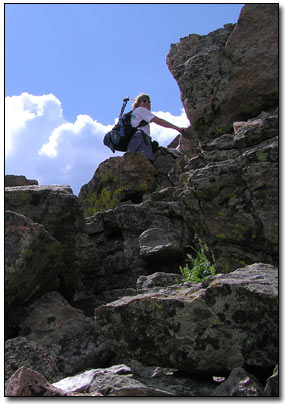|
With so many people obsessed with weight loss these days, it's only fitting that
manufacturers of outdoor equipment follow suit. But instead of cutting carbs, gear
makers are ditching heavy fabrics and extraneous features for lightweight materials
and efficient designs that offer exactly—and only—what outdoor enthusiasts need.
Unlike the Atkins Diet, lightweight gear is here to stay.
The key advantage of going lightweight, and that which is driving the ultralight
movement's popularity today, is that you can cover much more ground with a light
load on the shoulders—three times the distance in a single day in some cases. "Our
customers are going lightweight because they don't have a week to go
backpacking—they have a three-day weekend and want to do more," claims Chris
Lennert, VP of Sales at GoLite, a company that produces ultralight gear exclusively.
Product Director for The North Face Outerwear Damien Huang concurs, "People are
doing things a little bit faster on account of time commitments."

In other words, people are going lightweight so they can get more done while
attempting to escape their busy lives. Ironic but true.
"We've just seen a gradual shift, and it's across the board…In every segment of our
line, people are buying lighter," notes Huang explaining The North Face's recent
launch of their popular Flight Series line of fast and light gear. Now that the
masses have caught on to the true benefits of using lightweight gear, manufacturers
are responding with an arsenal of products.
The notion of ultralight backcountry travel was first popularized by Ray Jardine,
often credited as the father of the movement, with his seminal book on the subject
in 1992. He has debunked common misconceptions about how and what to pack
explaining, for example, that using a tarp and net-mesh for shelter instead of a
heavy tent can actually keep one warmer "because the tent traps moisture, even [one]
with large vents, and that moisture saps body heat."
Other key ways of reducing weight include ditching "luxury items" like a camp chair,
extra cookware, and excess food. Some backpackers carry toothpaste and sunscreen in
film canisters instead of their original packaging, sleep on a ¾-length pad instead
of a full-length model, and pare down provisions generally such as forgoing an extra
change of clothes.
In addition to a lightened load, there are some not so obvious benefits to traveling
lightweight. When backpacking, for example, they are multifold, and build off of
each other to yield some rather unexpected advantages. The most obvious is enhanced
comfort with less stress on the shoulders, back, and joints. A reduced pack weight
means you don't need heavy, clunky boots, eliminating even more weight, and allowing
for lighter, more agile footwear. In turn, the improved mobility of lighter footwear
can enhance safety while negotiating tricky terrain. Voila! Behold the positive
ripple effect of going lightweight.
There's another reason even seasoned athletes are trending toward lighter gear. "We
[have] started seeing a cultural shift in the things people [are] doing. It'd
probably take a sociology degree to explain," chuckles The North Face's Damien
Huang. "It's no longer enough to climb a mountain but how fast you do it, and in
what manner…rather than just hacking to the summit." As first ascents become ever
more elusive, backcountry enthusiasts are finding new ways to challenge themselves.
Before research and development of ultralight gear was underway in earnest consumers
worried about the quality of lightweight gear because they thought it sacrificed
strength and durability for a reduction in weight. Not so. Huang points out that,
"only in the last couple of years has it evolved to the point that you can provide
the same kind of performance as heavier garments…I think that's been the single most
important development in the category." For many it has proven that less is
more—more comfort, more safety, and more distance traveled.
| 
